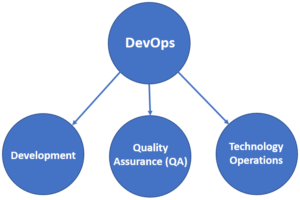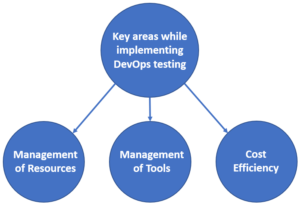Development and Operations (DevOps) is the agile software development approach that allows for simultaneous software development and testing. A successful DevOps practice requires quality assurance and testing (QAT). DevOps developed from the need for businesses to respond faster to market changes to acquire a competitive advantage and accelerate their growth.
DevOps is assisting firms with forming better collaborating teams of developers, operations, QA, and testers than ever before and contributes to the streamlining and simplification of existing group processes and workflows.
DevOps aims to improve the consistency of feature releases while also reducing problems and providing continuous and collaborative application development and deployment. It’s not only about continuous delivery; it’s also about continual software enhancement.

Let’s talk more about the three pillars of DevOps.
Development
The development team is always developing new software or applications to meet changing customer needs or market demands for new features, as well as making product updates and improvements.
QA
QA acts as a mediator between the development and operations teams in delivering business value.
Technology Operations
To ensure the highest level of software stability and availability, the operations team tries to maintain as much consistency as possible.
Testers and developers are equally important in the DevOps strategy. QA bridges the gap between development and operations, allowing them to collaborate on software and application functionality. They act as a mediator between the development and operations team to deliver the product smoothly.
Everyone in the company is responsible for quality and consistency, hence the company’s success. Continuous testing ensures that the delivery cycle runs smoothly. It shortens the time between development and implementation.
Importance of DevOps
DevOps helps the development and operations teams to work together as a single team to deliver business value.

Below are best practices for QA in DevOps.
- Quality must be well-defined to meet requirements. QA should focus on delivering a good user experience in the time given.
- Technical teams should include QA and testing teams. They should focus their efforts on automation testing methodologies including manual functional testing.
- Individual and team goals must be optimized. By encouraging quality assurance, organizations can enhance essential behavior and cultural shifts.
- To assist and lead development teams on the right path, QA teams should be actively involved in the requirements process. Requirements should be specific.
- Software defects should be detected early in the development cycle. Quality-measurement metrics must be defined and measured.
- Testing must move towards automation wherever possible.
- Testing should focus more on automated regression testing on critical areas.
- Development, operations, and QA teams should be able to communicate, collaborate, and streamline their efforts.
- For a successful continuous delivery process that eliminates risks, reduces costs, and speeds time to market through frequent releases, a fully automated continuous testing process must be included in the software development life cycle.
- Continuous integration is the key to detecting errors early in the development lifecycle. To implement continuous integration efficiently, all the stakeholders must integrate their work often daily.

Below are key areas while implementing DevOps testing:
Management of Resources
A successful DevOps implementation relies heavily on effective resource management. DevOps is an agile testing environment, so you need a mix of skills to complement each other on the project.
Management of Tools
Open-source tools are available for trial and can be implemented without much organizational monitoring. However, this has the potential to produce issues in the long run. Traditional testing tools cannot be used for agile automation testing because this would require you to wait until the program is complete, defeating the entire point of DevOps.
Cost Efficiency
Another major problem is the financial aspect. We’re all aware that implementing DevOps necessitates a significant financial commitment to infrastructure, tools, and other resources.
Why This DevOps Information Matters
DevOps aims to streamline and automate the entire software delivery lifecycle. A successful DevOps testing plan begins with implementing the agile best practice of Continuous Integration (CI), where the code was written and committed into a shared repository, which will be built, deployed, tested, and installed on the production environment. QA plays an important role in delivering a high-quality product to clients. With the support of DevOps, the QA can bridge the gap between team requirements and make testing and development work more collaborative. For more information, contact our experts today.


Excellent Blog!
Thanks Akash!
Good one in very simple terms!
Very well explained, thanks for sharing!
Thanks Sara!
Thanks Krishna!
Excellent blog! What are the statuses used by a QA tester in DevOps? We just transitioned to DevOps but for the QA department we don’t have yet statuses and this makes the testing difficult.